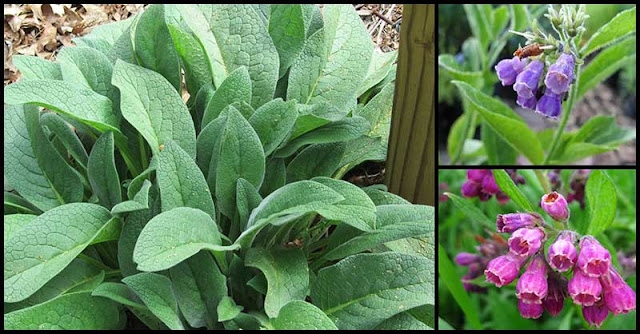Historically, comfrey has been used for all manner of injuries, wounds that are not healing properly, and for tuberculosis and irritating dry lungs complaints.
Comfrey grows well in moist soils. Its flower can range in color of white, purple or blue. Its roots are filled with juice. This versatile herb is also known as Knitbone, Black Root, Blackwort, Bruisewort, Consound, Boneset, Ass Ear, Gum Plant, Healing Herb, Knitback, Salsify, Slippery Root, and Wallwort.
Found in the plant’s roots and leaves is a compound known as allantoin which has been found to help grow new cells and has the ability to regenerate connective tissues. Aside from this, other helpful ingredient and compounds are also present in the herb. Some of them are vitamin B12, vitamin A, vitamin C, sulfur, potassium, calcium, phosphorus, amino acids, fiber, protein, antioxidants, hydroxy cinnamon acid derivatives, mucopolysaccharides.
Comfrey leaves and the roots contain vitamin A, vitamin B12, vitamin C, calcium, potassium, phosphorus, sulfur, fibers, amino acids, and other natural compounds.
What Causes of Joint Pain
In our body, joints are the areas where our bones are connected with one another, such as knee and the hips, elbows, ankles, and shoulders.
Joint pain refers to aches, soreness, and discomfort in any of the body’s joints. Arthritis is one of the most common causes of joint pain. It can affect the wrists, hands, hips, and knees.
Some of its other causes include:
- gout
- an injury
- tendinitis, or inflammation of the tendon
- bursitis, or inflammation of the cushioning pads around joints
- kneecap
- lupus
- overuse of a joint
- osteoporosis
- sarcoidosis
- rickets
- cancer
- an infection of the bone
- overuse of a joint
- fibromyalgia
- certain infectious diseases, such as mumps, influenza, and hepatitis
- chondromalacia of the patella, or a breakdown of the cartilage in the kneecap
Comfrey Against Joint Pain and Inflammation
Research has found that comfrey leaves and root can help heal wounds and inflammation of the muscles and joints.
The powerful healing properties of allantoin in comfrey if the one found to be responsible for relieving sprain, joint pain, and inflammation of the muscles and ligaments. Moreover, rosmarinic acid, which is another medicinal ingredient present in comfrey, can also help lessen inflammation.
Other Health Benefits of Comfrey
Health benefits of this beautiful flowering plant include:
Boost the Immune System
Comfrey’s vitamin C content plays a role in stimulating the white blood cells production which is the first line of defense of the body’s immune system.
Wound Healing
Comfrey paste, when applied on the skin, has some benefits on rashes and irritations. Due to its antioxidants, it can speed up the healing of wounds, eliminate foreign substances in the body, and prevent cell death. Plus, its vitamin C content plays a role in the production of collagen which is needed for the production of new skin cells.
Menopause and Vaginal Health
According to experts, external use of comfrey can help prevent vaginal dryness after menopause. It can also easily treat genital infections. Comfrey oil has been found to be effective against candida vaginitis and chronic cervicitis.
Bone Health
When applied topically, comfrey paste can help repair broken bones and damaged tissues in a shorter period. Calcium, which is needed for bone growth, is also present in comfrey. Due to the presence of a unique combination of organic compounds, the plant can help in more efficient uptake and use of these minerals within the body.









